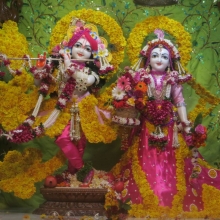ISKCON
The International Society for Krishna Consciousness was founded by His Divine Grace A.C. Bhaktivedanta Swami Prabhupada in 1966. It belongs to the Gaudiya Vaisnava tradition, a devotional tradition based on the teachings of Bhagavad-gita and Srimad-Bhagavatam.
The precepts and practices of ISKCON were taught and codified by the 15th century saint and religious reformer Sri Caitanya Mahaprabhu and his principle associates, the Six Goswamis of Vrindavana.
Sri Caitanya, whom devotees revere as a direct incarnation of Krishna, gave a powerful impetus for a massive bhakti (devotional) movement throughout India. Under his direction hundreds of volumes on the philosophy of Krishna consciousness were compiled. Many devotees have followed in the line of Sri Caitanya Mahaprabhu including, in the 19th century, an outstanding Vaisnava theologian, Bhaktivinoda Thakura who brought Krishna consciousness to a modern audience.
Bhaktivinoda’s son, Bhaktisiddhanta Sarasvati Goswami, became the guru of Srila Prabhupada and instructed him to spread Krishna consciousness in the West.
Disciplic succession:
The International Society for Krishna Consciousness draws its legitimacy from its place in a long succession of spiritual teachers and disciples (parampara). There are four major disciplic successions (sampradayas), ISKCON belongs to the Brahma Sampradaya, founded by Lord Krishna Himself.
There are many branches to this sampradaya. Our society belongs to the branch founded by Sri Caitanya Mahaprabhu in the 16th century.
The principle is that Vaisnava teachings should be passed on, unchanged, from guru to disciple. The most prominent devotees in this lineage are accepted as acaryas: those who teach by example, who carry the line forward. Listed below are the acaryas s, starting from Lord Krishna Himself all the way down to the Founder Acharya of ISKCON Srila Prabhupada:
| 1. Krsna 2. Brahma 3. Narada 4. Vyasa 5. Madhva 6. Padmanabha 7. Nrhari 8. Madhava |
9. Aksobhya 10. Jaya Tirtha 11. Jnanasindhu 12. Dayanidhi 13. Vidyanidhi 14. Rajendra 15. Jayadharma 16. Purusottama |
17. Brahmanya Tirtha 18. Vyasa Tirtha 19. Laksmipati 20. Madhavendra Puri 21. Isvara Puri, (Nityananda, Advaita) 22. Lord Caitanya 23. Rupa,(Svarupa, Sanatana) 24. Raghunatha, Jiva |
25. Krsnadasa 26. Narottama 27. Visvanatha 28. (Baladeva) Jagannatha 29. Bhaktivinoda 30. Gaurakisora 31. Bhaktisiddhanta Sarasvati 32. A. C. Bhaktivedanta Swami Srila Prabhupada. |
Chronological History of the Hare Krishna Movement
The International Society for Krishna Consciousness (ISKCON) commonly known in the West as the Hare Krishna Movement comes in a tradition that traces all the way back to Lord Krishna Himself. ISKCON was founded in New York in 1966 by His Divine Grace A. C. Bhaktivedanta Swami Prabhupada (1896-1977), referred to as Srila Prabhupada. His spiritual teacher, Bhaktisiddhanta Saraswati Thakura, asked him to teach Bhakti to the English-speaking world.
- At 69 years old, Srila Prabhupada arrived in Boston in 1965. By 1966 he was living in New York City and had developed a following.
- From 1966 to 1968, temples were established in New York, Los Angeles, San Francisco, Seattle, Montreal, and Santa Fe, New Mexico. The first Ratha-yatra outside of India was held in San Francisco and began an annual ISKCON tradition in more than 20 major cities around the world.
- From 1971 to 1973, temples opened in Europe, Canada, South America, Mexico, London, Africa, and India.
- In 1970, the Governing Body Commission, ISKCON’s international managerial body, was established to oversee the Society, which had grown to close to one hundred temples, schools, restaurants, and farm communities.
- From 1970 to 1977, ISKCON built major centers at the pilgrimage sites of Mayapur and Vrindavana, India, and a large temple in Bombay.
- In 1972, Srila Prabhupada founded the publishing house Bhaktivedanta Book Trust (BBT), now the world’s largest publisher of books on Bhakti yoga. Krishna.com is sponsored and maintained by the BBT.
- In 1973, the Bhaktivedanta Institute was formed to write books and magazines and to hold conferences to present the teachings of the Vedas in scientific terms.
- From 1974 to the present, ISKCON Food for Life has run food relief programs in dozens of cities around the world.
- In November 1977, Srila Prabhupada passed from this world. ISKCON had 108 temples and more than 10,000 followers.
- In 1989, the Hare Krishna movement come out from underground in the Soviet Union, as glasnost brought an end to persecution.
- By 1991, more than one million copies of Srila Prabhupada’s Bhagavad-gita As It Is had been sold in the former Soviet Union.
- In the early 1990’s, Krishna.com is launched, as well as ISKCON.com and other Hare Krishna websites.
- Today, ISKCON has about 400 centers around the world, with a worldwide congregation in the tens of thousands, from all walks of life.







